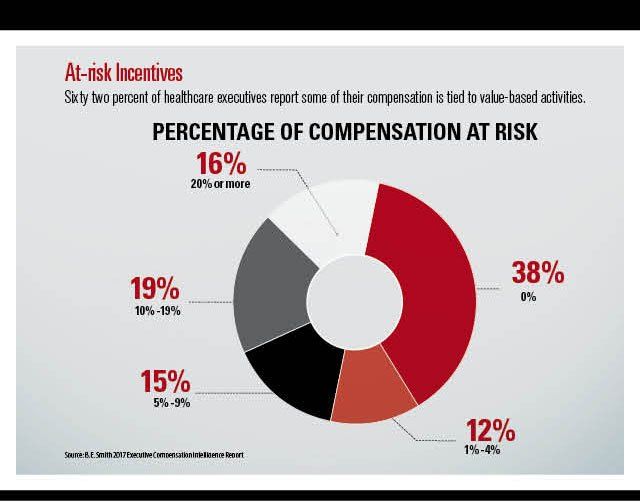Top Ways Health Executive Compensation is Changing
As demands on healthcare organizations rise with the transition to value-based care, healthcare executives are being paid differently.
At-risk Incentives

Executives that benefit most from value shift

LONG-TERM INCENTIVE PLAN PROVISIONS

Trickle-down effect

Sullivan

Greenblat

Kerper

Rumans

The transition to value-based care has put pressure on healthcare leaders to do more-and to do better-with less. But finding and retaining executives who are up to the task, especially under old compensation models, can be a struggle. That’s why more organizations are exploring alternative compensation plans.
Sixty two percent of more than 250 healthcare executives who responded to a 2017 survey by executive search and consulting firm B.E. Smith report that a portion of their compensation is at risk for value-based activities. Another 20% report that changes to better align compensation with value-based metrics are in progress. The top targets executives said they are being tasked to meet are related to operating margins and cash flow, growth, patient engagement and satisfaction, and clinical performance.
Gradual shift
Approving new compensation plans requires a fundamental shift in thinking among the hospital and healthcare system board members who determine executive compensation plans, says Steven Sullivan, managing director at the executive compensation consulting firm Pearl Meyer. These board members often have experience with nonprofit groups and charities and are not accustomed to rewarding executives for performance, as the for-profit or private sector is.
“Historically, healthcare executive compensation has been used in ways that have not been very effective,” Sullivan says. “The philosophy has always been that the executives were not there to get rich, but to fulfill the mission.”
When the ACA was implemented, many hospital board members were forced to consider alternative compensation models for their C-suite leaders, says Sullivan. That’s because reform presented transformational challenges that required sustained collaborative efforts. “Boards that were more forward-thinking began to establish leveraged approaches to variable compensation for recruiting, motivating, and retaining their leaders through difficult transformations,” he says.
The need to provide alternative models intensified as the Triple Aim became part of many providers’ strategic plans, says Sullivan, noting that finding executives who are qualified to take on the goals of better health outcomes, happier patients, and lower costs, is difficult. The need to advance the Triple Aim “further split the herd in terms of the relatively limited number of executives who were qualified to take on that challenge,” Sullivan says.
New metrics added
Many new compensation plans include a base salary, an annual incentive plan, and a long-term incentive opportunity, says Sullivan. The annual incentive may be based on a short list of goals related to addressing the organization’s vulnerabilities-often clinical quality or efficiency problems.
Since not everything can be achieved in a 12-month cycle, long-term incentive plans are also being implemented within many healthcare systems and hospitals. Often, long-term incentive plans come in the form of a performance share plan, where executives are compensated by earning stock in their organization, says.
The types of goals included in these long-term plans depend on the type of organization and its long-term mission or strategy, Sullivan says. Not-for-profit hospitals that have a good donor base and are performing well might focus on patient experience and growing the business among commercially insured patients. Safety net hospitals that are just trying to stay in the black might focus on improving efficiency and clinical quality. “Those are the only two things they have at their disposal to control over time,” Sullivan says.
Whatever the goals, the compensation plan is created based on a consensus about the future needs of the organization and the goals that must be achieved to get there, says Sullivan.
Bruce Greenblatt, managing principal at the executive performance consulting firm Sullivan, Cotter and Associates, Inc., agrees that the use of long-term incentive programs to provide rewards for multi-year transformation outcomes is becoming more prevalent, particularly among the largest organizations. Also, he says, more organizations are using retention awards and long-term incentives to support the stability of the senior executive leadership team during this period of transformation
Quality is king
Compensation plan metrics often include defined ranges of performance, and pay is tied to whatever level is reached within those ranges. For example, there might be no additional compensation given for meeting a threshold marker, but percentages of additional compensation will rise as executives exceed the threshold.
Warren Kerper, managing principal at Sullivan, Cotter and Associates, Inc., says incentive plan measures for health executives often include, in addition to financial performance, quality improvement, member engagement, and operational efficiency.
Greenblatt says quality is key in almost every executive compensation package. In fact, SullivanCotter’s 2017 Manager and Executive Compensation in Hospitals and Health Systems Survey polled 30,000 executives and revealed that an average of 20% of an executive’s annual incentive payout is tied to quality measures. “An additional 16%, on average, is tied to the achievement of patient experience goals,” Greenblatt says. “The tie to value-based care is very prominent-in fact, the combined weight of these measures is typically greater than the weight placed on financial performance measures.”
Mark Rumans, MD, managing principal and chief medical officer at Sullivan, Cotter and Associates, Inc., says internal data and externally published ratings and rankings on benchmark performance and areas of improvement is typically used to identify compensation goals related to quality and patient experience. “When using the appropriate peer groups, resources like the CMS Star Ratings or U.S. News and World Report Rankings provide a great way for organizations to determine how they are performing in relation to their counterparts,” Rumans says. “While understanding the nuances and complexities in this data can be challenging, analyzing variances to these benchmarks can help organizations set meaningful goals and align their compensation accordingly.”
What’s coming
Moving forward, Sullivan says more will have to be done beyond just adding value-based measures and compensation. The healthcare model must be changed in a way that can be sustained in a long-term manner. This means finding a way to close the space between payers and providers, Sullivan says.
“I think the biggest problem right now is provider organizations are not receiving sufficient reimbursement from insurance companies,” he says. “And the turmoil in Washington is keeping us from having a responsible and mature approach.”
He says payers are struggling to anticipate the direction of the federal government, and providers are struggling to meet ever-changing criteria and performance levels. “It doesn’t match up,” says Sullivan. “We’ve got to get better consensus and alignment between the payers and providers, and hopefully that will force Congress to come to terms with the situation.”
Rachael Zimlich, RN, is a writer in Columbia Station, Ohio.
Extending the Capabilities of the EHR Through Automation
August 2nd 2023Welcome back to another episode of "Tuning In to the C-Suite," where Briana Contreras, an editor of Managed Healthcare Executive, had the pleasure of chatting with Cindy Gaines, chief clinical transformation officer at Lumeon.
Listen
Automate Your Practice's Workflows with These 5 Tools
October 4th 2023To maintain patient satisfaction and regulatory compliance and reduce potential clerical errors while maintaining high productivity, you can ease your staff’s burdens by automating your practice’s workflows and empower your staff to do more in less time.
Read More